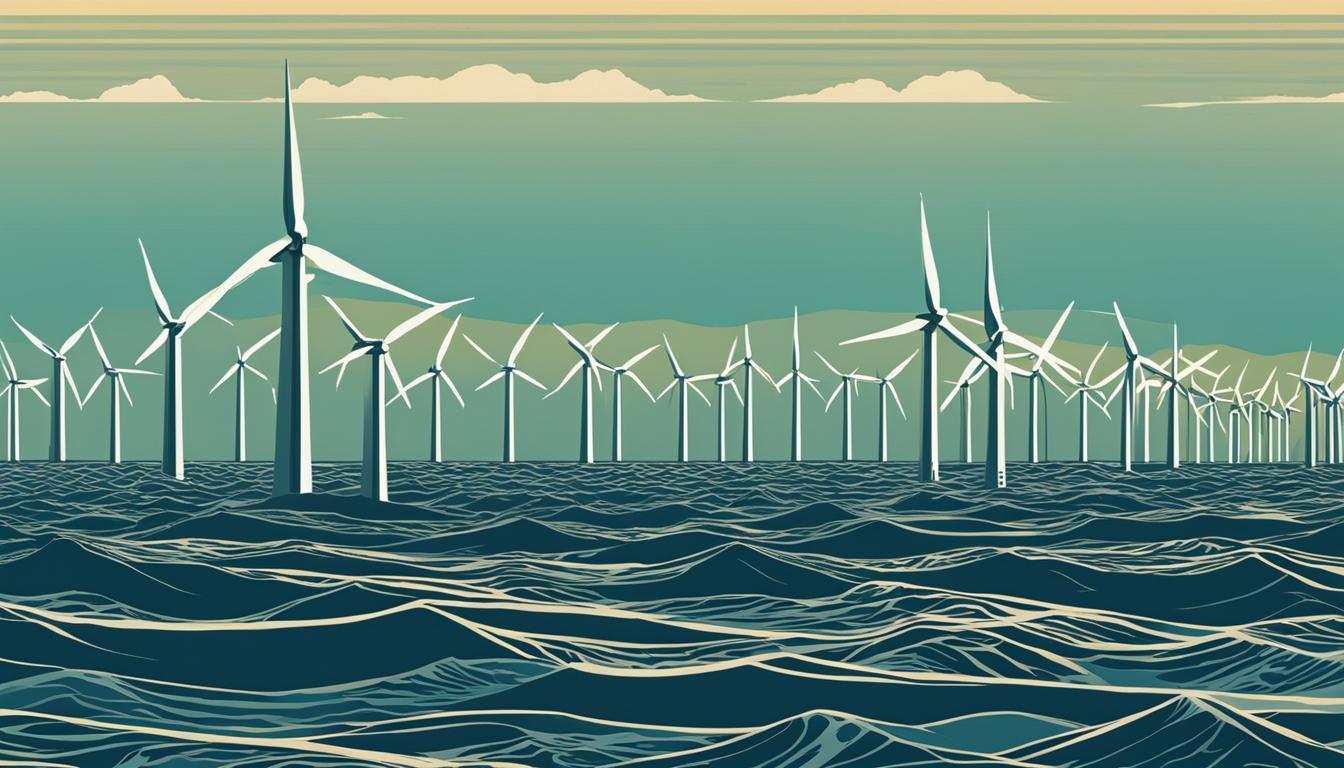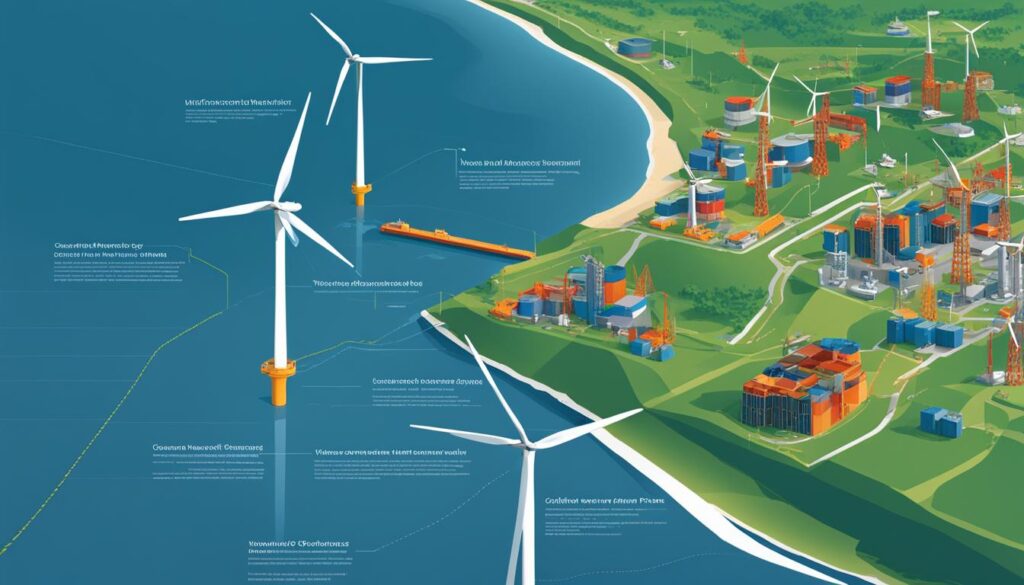
Offshore wind farms are experiencing rapid growth and are shaping the future of renewable energy. According to research, global installed offshore wind capacity is projected to reach 630 gigawatts (GW) by 2050, a significant increase from 40 GW in 2020. This growth is driven by expanding government commitments and technological advancements in established and emerging markets.
Europe currently leads in offshore wind capacity, with projections to increase by 7 percent annually to reach 190 GW by 2050. The Asia-Pacific region is expected to surpass Europe in capacity by the mid-2030s, with Mainland China alone projected to have 240 GW of installed capacity by 2050. The Americas, particularly the United States, are also expected to see substantial growth in offshore wind, driven by government goals and initiatives. Technological advancements, such as floating foundations and larger turbine sizes, are expanding the viable sea area for offshore wind and reducing the levelized cost of electricity (LCOE) for offshore wind projects.
Explore Advanced Insights into Wind Turbines
For a comprehensive understanding of turbine mechanics and technology, check out our detailed guide on how wind turbines work – Here
Check out our comprehensive breakdown of floating wind turbines anatomy and functionality in our in-depth article – Here
Offshore Wind Farms Market Outlook
The offshore wind market is experiencing global support and strong technological progress. Offshore wind projects are now being pursued by countries across the globe, from Europe and the Asia-Pacific region to the Americas. Europe currently has the largest base of installed offshore wind capacity, with projections to increase to 190 GW by 2050. The Asia-Pacific region, led by Mainland China and Taiwan, is expected to overtake Europe in capacity by the mid-2030s and install 410 GW by 2050. The Americas, particularly the United States, are in the early stages of offshore wind development but have set ambitious targets, with the goal of installing 30 GW of capacity by 2030. Technological advancements, such as floating foundations and larger turbine sizes, are expanding the potential for offshore wind in deeper waters and reducing the cost of electricity generated from offshore wind projects.

Offshore wind market growth is driven by the increasing global commitment to renewable energy and the need to reduce greenhouse gas emissions. Governments and industries recognize the potential of offshore wind as a clean and sustainable energy source that can contribute to energy security and economic growth. The growing demand for renewable energy and the need to achieve climate change targets are propelling the expansion of the offshore wind market worldwide.
Technological progress is playing a crucial role in the growth of the offshore wind market. Advancements in floating foundations have opened up new possibilities for installing wind turbines in deeper waters, where wind conditions are often more favorable. Larger turbine sizes are also improving the efficiency and cost-effectiveness of offshore wind projects. These technological innovations are expanding the geographical reach of offshore wind and unlocking new areas for development.
| Region | Installed Capacity (GW) by 2050 |
|---|---|
| Europe | 190 |
| Asia-Pacific | 410 |
| Americas | 30 |
Offshore Wind Challenges and Risks
While the offshore wind industry presents significant growth opportunities, it also comes with its fair share of challenges and risks. Companies looking to pursue offshore wind projects must navigate commercial requirements, tackle difficult project economics, and build or bolster necessary capabilities.
Government tenders and auctions that allocate offshore wind capacity often come with specific commercial requirements that companies must meet to secure projects. These requirements can include criteria such as local content quotas, job creation targets, and environmental regulations. Adhering to these requirements adds complexity to project planning and execution, as companies need to balance economic viability with meeting these mandates.
Project economics can be challenging for offshore wind projects due to fluctuating raw material prices and the limited availability of construction equipment and wind turbine installation vessels. The construction and installation phases face cost pressures, and companies need to carefully manage their supply chain and logistics to control expenses.
Commercial Requirements
In order to secure offshore wind projects, companies must meet specific commercial requirements set by authorities. These requirements can include local content quotas, job creation targets, and environmental regulations.
Project Economics
Offshore wind projects face challenges in terms of project economics due to fluctuating raw material prices and limited availability of construction equipment and wind turbine installation vessels.
Building Capabilities
Companies pursuing offshore wind projects need to build or bolster their capabilities in areas such as supply chain management, port infrastructure upgrades, and local job creation. These capabilities are essential for successful project execution and meeting government requirements.
| Challenges | Solutions |
|---|---|
| Commercial requirements | Adhering to regulations and building partnerships |
| Project economics | Strategic cost management and supply chain optimization |
| Building capabilities | Investing in infrastructure and local workforce development |
Strategies for Success in Offshore Wind
In order to achieve success in the offshore wind industry, companies must develop effective strategies that encompass various key areas. One crucial aspect is project development, which involves conducting market analysis, selecting suitable sites, and participating in capacity tenders. Companies need to excel in bidding for these tenders, leveraging their expertise and capabilities to secure remuneration agreements and secure their place in the market.
Predevelopment activities are also critical for success. Building connections with local stakeholders, understanding the regulatory environment, and having a clear strategy are all essential to navigate the complexities of offshore wind projects. By having a robust predevelopment phase, companies can lay the foundation for successful project execution.
Project execution itself requires careful attention to optimizing project economics and effectively managing capital-project development costs. Companies must focus on building capabilities in areas such as supply chain management, port infrastructure upgrades, and local job creation. These capabilities will support the smooth implementation of offshore wind projects and contribute to their overall success.
Key Strategies for Success in Offshore Wind:
- Excel in bidding for capacity tenders
- Build connections with local stakeholders
- Understand and adapt to the regulatory environment
- Optimize project economics
- Manage capital-project development costs
- Develop capabilities in supply chain management
- Invest in port infrastructure upgrades
- Create local job opportunities
By focusing on these strategies and continuously adapting to the evolving offshore wind market, companies can position themselves for long-term success and contribute to the growth of the industry as a whole.

Offshore Wind Market Trends in the U.S.
The U.S. offshore wind market is experiencing significant growth and is set to become a major player in the global offshore wind industry. One notable trend in the U.S. market is the decreasing auction prices for offshore wind projects. As the technology advances and economies of scale are realized, the cost of developing offshore wind farms has been steadily declining. This trend is bringing down the leveled cost of electricity (LCOE) for offshore wind projects, making them more competitive with traditional energy sources.
Another trend shaping the U.S. market is the increasing water depths of offshore wind projects. Traditionally, offshore wind farms were installed in relatively shallow waters close to the coast. However, as companies explore new sites with more favorable wind conditions and reduced visual impact, they are venturing into deeper waters. Technological advancements, such as floating substructures, have made it economically feasible to install turbines in these deeper waters, unlocking new areas for offshore wind development.
Current State of the U.S. Offshore Wind Market
The U.S. offshore wind market is gathering momentum, driven by government support and an increasing number of projects in the development pipeline. According to the Department of Energy’s Offshore Wind Market Report, there is a potential generating capacity of over 35,000 megawatts (MW) in the project development pipeline. Several states, including Massachusetts, New York, and New Jersey, have set ambitious targets for offshore wind capacity, creating a favorable regulatory environment for project development.
Opportunities and Challenges
The expanding U.S. offshore wind market presents numerous opportunities for companies involved in the renewable energy sector. With decreasing auction prices and the increasing viability of deeper water projects, there is a growing potential for investment and innovation in the industry. However, there are also challenges to overcome, such as regulatory processes and environmental considerations. Balancing the need for clean energy with the preservation of marine ecosystems and wildlife is a key challenge that industry stakeholders are addressing through careful planning and collaboration.
| Key Trends: | Implication: |
|---|---|
| Decreasing auction prices | Increased competitiveness and cost-effectiveness of offshore wind projects |
| Increasing water depths | Expanding potential for offshore wind development in deeper waters |
Despite the challenges, the U.S. offshore wind market is positioned for significant growth in the coming years. As the industry continues to mature and technological advancements drive down costs, offshore wind is poised to become a key component of the U.S. energy transition, contributing to a cleaner and more sustainable future.
Future Outlook and Opportunities in the Offshore Wind Market
The offshore wind market is poised for remarkable growth, driven by the increasing global demand for clean and sustainable energy sources. Despite the challenges in terms of commercial requirements, project economics, and technological advancements, there are significant opportunities for companies in this dynamic industry.
Technological progress, such as the development of floating foundations and larger turbine sizes, is paving the way for offshore wind projects to expand their global reach. These advancements not only enable the utilization of deeper waters but also contribute to reducing the levelized cost of electricity (LCOE) for offshore wind developments.
As the industry continues to evolve, regions like Europe, the Asia-Pacific, and the Americas are projected to contribute to the offshore wind market growth. Europe, with its established market, leads in offshore wind capacity, while the Asia-Pacific region is expected to overtake Europe in the mid-2030s. The Americas, particularly the United States, are in the early stages of offshore wind development but have set ambitious targets. All these regions provide ample opportunities for companies to participate in the expanding offshore wind sector. You can check expected growth from Mckinsey
While industry challenges persist, the positive market outlook and the increasing global momentum toward renewable energy make the offshore wind market an attractive arena for companies aiming to make a significant impact in the energy transition. By staying ahead of technological advancements, leveraging global opportunities, and effectively addressing industry challenges, companies can position themselves for success in the thriving offshore wind market.
